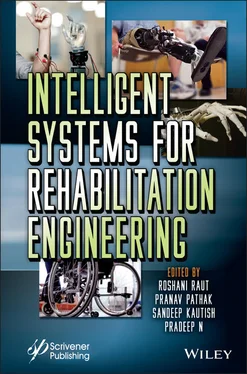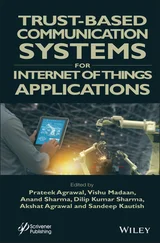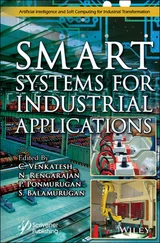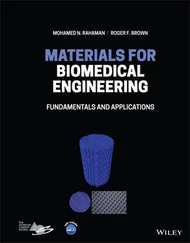Intelligent Systems for Rehabilitation Engineering
Здесь есть возможность читать онлайн «Intelligent Systems for Rehabilitation Engineering» — ознакомительный отрывок электронной книги совершенно бесплатно, а после прочтения отрывка купить полную версию. В некоторых случаях можно слушать аудио, скачать через торрент в формате fb2 и присутствует краткое содержание. Жанр: unrecognised, на английском языке. Описание произведения, (предисловие) а так же отзывы посетителей доступны на портале библиотеки ЛибКат.
- Название:Intelligent Systems for Rehabilitation Engineering
- Автор:
- Жанр:
- Год:неизвестен
- ISBN:нет данных
- Рейтинг книги:4 / 5. Голосов: 1
-
Избранное:Добавить в избранное
- Отзывы:
-
Ваша оценка:
- 80
- 1
- 2
- 3
- 4
- 5
Intelligent Systems for Rehabilitation Engineering: краткое содержание, описание и аннотация
Предлагаем к чтению аннотацию, описание, краткое содержание или предисловие (зависит от того, что написал сам автор книги «Intelligent Systems for Rehabilitation Engineering»). Если вы не нашли необходимую информацию о книге — напишите в комментариях, мы постараемся отыскать её.
Encapsulates different case studies where technology can be used as assistive technology for the physically challenged, visually and hearing impaired.
Audience Intelligent Systems for Rehabilitation Engineering
Intelligent Systems for Rehabilitation Engineering — читать онлайн ознакомительный отрывок
Ниже представлен текст книги, разбитый по страницам. Система сохранения места последней прочитанной страницы, позволяет с удобством читать онлайн бесплатно книгу «Intelligent Systems for Rehabilitation Engineering», без необходимости каждый раз заново искать на чём Вы остановились. Поставьте закладку, и сможете в любой момент перейти на страницу, на которой закончили чтение.
Интервал:
Закладка:
– Chapter 1discusses the different spheres of rehabilitation robotics. Robots are being widely used in medical practice to support various procedures and therapies to help people with physical and psychological limitations. A survey was conducted on rehabilitation robotics that reviews Preface rehabilitation robots with an eye towards future applications. Many researchers have collaborated on an integrated human-robot structure with cognitive abilities; and orthotic and prosthetic devices can also benefit from rehabilitation robots. Additionally, sensing technology is being used in rehabilitation robots. Moreover, this chapter examines the use of rehabilitation robots in Europe and North America.
– Chapter 2reviews the use of neurorehabilitation robots for an automated process for the upper limb. This chapter illustrates and defines all areas of mechanical recovery technology for novices, and captures the recent robot advances being widely used by talented scientists and clinicians. Also, a few company devices for mechanical recovery are given for a better understanding of the complete picture. The use of productive robotic methodologies promotes the recovery of motor skills. This innovation combines the outcomes of social investigations on motor learning and neurological recovery in the creation and execution of automated processes, with the approval of robot specialists who operate as ideal instructors. Human-robot collaboration assumes a leading role in creating a beneficial relationship, where the human body and the robot can benefit from each other’s components.
– Chapter 3highlights an effective affordable rehabilitation robot for nervous system disorders powered by dynamic convolutional neural network (CNN) and hidden Markov model (HMM). Neurological disorders are a frequent health concern of billions of individuals around the world. This condition is caused by malfunctioning of the central and peripheral nervous systems. For example, Alzheimer’s and Parkinson’s diseases are not uncommon and wreck the lives of many people. In particular, those afflicted with Parkinson’s disease have impaired movement resulting in freezing of gait (FOG). The only accessible treatment option is the artificial creation of dopamine levels. Therefore, robotic rehabilitation devices have been proposed which apply vibrations to activate muscle performance. These bracelets, bands, and chains are part of the sensors which are fixed to the patient’s body. For processing sensor signals and decision-making, CNN and HMM are used.
– Chapter 4focuses on smart sensors for activity recognition. Health informatics is used to collect, store, and retrieve essential health-related data. Information and communication technologies and wireless connections lead to the creation of smarter sensors. These devices are commonly used for self-monitoring of health and well-being. Use of smart sensors could help healthcare providers monitor the daily activities of the elderly. Also addressed in this chapter is the use of machine learning (ML) techniques on smartphones and wearables to capture and model human body motions and vital signs during activities of normal living.
– Chapter 5discusses the use of assistive technology for those who are visually impaired. Acquiring knowledge is difficult for the blind, with Braille being the most commonly utilized technique of transferring information to them. These new forms of Braille include American Literary Braille, British Braille, Computer Braille, Literary Braille, Music Braille, and so on. Traditional Braille writing employs a slate and stylus. Other forms of Braille writers and computer software, such as voice recognition software, special computer keyboards and optical scanners, have been developed. Virtual Pencil math software, Audio Exam Player, and educational chatbots are a few examples of smart education solutions for the visually impaired. This chapter presents an overview of different rehabilitation procedures.
– Chapter 6discusses IoT-assisted smart devices for the blind. Since blind people face several challenges, a lot of effort has been put into making them less reliant on others to perform tasks. As a result, we conceptualized and constructed an intelligent blindfold. Also, a smart walking stick helps visually impaired people safely move around without assistance. Even though several walking sticks and aids currently exist, they do not feature run-time autonomous navigation, object detection, identification warnings, or voice and face recognition. The proposed stick combines IoT, echo location, image processing, artificial intelligence and navigation system technology to help the user avoid obstacles.
– Chapter 7focuses on the use of a technology that offers mobile accessibility to people with disabilities, who face numerous physical, social, and psychological problems. Inmany aspects of life, cutting-edge technologies are critically important. Mobile technology revolutionized the process of communication as well as education, business and rehabilitation. Many development platforms now have accessibility features that assist developers in designing apps by leveraging machine learning and deep learning, which benefit those with disabilities. A wide range of applications are available, but they all have advantages and disadvantages. The results of investigations may help those with disabilities find new alternatives that offer substantial assistance.
– Chapter 8presents a smart solar-powered wheelchair. Mobilization is a requirement for those with disabilities, and for those with a serious impairment a mechanical wheelchair isan adequate alternative. Because mechanical wheelchairs present a significant risk of upper limb strain and injury, electric-powered wheelchairs were invented to help reduce this risk. However, inelectric-powered wheelchairs, motors are powered by batteries and hence have limited travel range and need frequent recharging. These limits can be eliminated by adding a thin-film solar panel that can be mounted behind the wheelchair as a folding, retractable roof, which doesn’t employ a fixed, large, and heavy fixed panel that cannot be dismantled. Various design options, including smart controls that use electroencephalography (EEG) signals, smart navigation systems, and data acquisition via the IoT are also being considered.
– Chapter 9discusses hand-talk assistive technology. For those who are deaf, enabling their ability to communicate requires creative technology. Therefore, many technologies may be employed for communication. Since their major form of communication is gestures, a non-signing individual is unable to comprehend hand motions; therefore, a sign language-to-audible voice conversion technique is required in order for a person with “normal” hearing to be able to understand what is being said. This chapter discusses the technology that allows the deaf to converse with the general population by employing special sensor gloves. As the speech-and-hearing impaired person moves, their moving hand uses sign language, and the technology will intercept the movement and transform it into sound so that the person with “normal” hearing can easily hear it. For those that are speech-and-hearing impaired, speech recognition systems using EEG signals, smart navigation systems, and data collection via the IoT are also described in this chapter.
– Chapter 10discusses assistive technology for hearing-impaired children. Appropriate educational services are critical for children with hearing impairment (CwHI) due to diseases or accidents. Current research reveals that using assistive technology (AT) to communicate fully with others in an inclusive educational settingis highly beneficial for these children. Assistive technology has a strong influence on integrating these children in schools. Additionally, self-motivation is another benefit of using AT for CwHI. Assistive technology is the use of any communication device used to raise, expand, or enhance the experiences of a CwHI. It promotes the concept of beautiful individuality and works toward the aim of inclusive education by helping students manage their own needs. An inclusive education model studied CwHI, and the results of many trials, methodologies, and facilities are discussed in this study. Also described are various techniques that enhance capabilities and resources to ensure that the AT can provide an inclusive classroom environment.
Читать дальшеИнтервал:
Закладка:
Похожие книги на «Intelligent Systems for Rehabilitation Engineering»
Представляем Вашему вниманию похожие книги на «Intelligent Systems for Rehabilitation Engineering» списком для выбора. Мы отобрали схожую по названию и смыслу литературу в надежде предоставить читателям больше вариантов отыскать новые, интересные, ещё непрочитанные произведения.
Обсуждение, отзывы о книге «Intelligent Systems for Rehabilitation Engineering» и просто собственные мнения читателей. Оставьте ваши комментарии, напишите, что Вы думаете о произведении, его смысле или главных героях. Укажите что конкретно понравилось, а что нет, и почему Вы так считаете.












